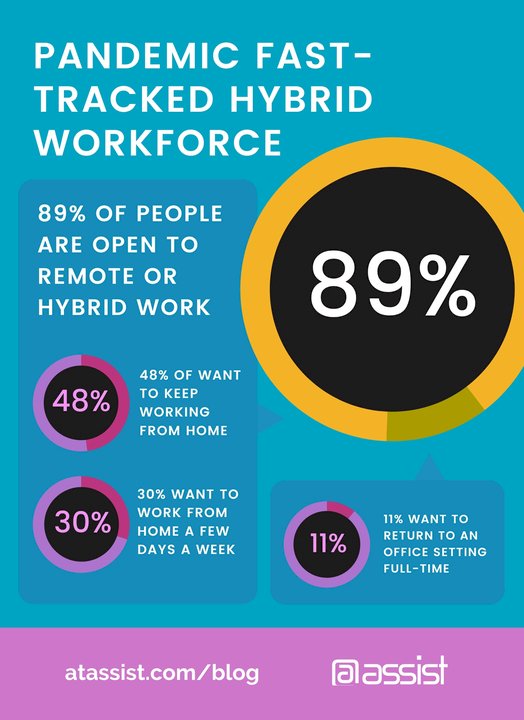Why Workflow Management Software Remains Essential in Hybrid Workspaces
Over the past year, many people experienced changes to their work situations. More workplaces than ever moved to remote work, and employees at to adjust to working without face-to-face interaction. This led to video chats and communication tools like Slack rising exponentially in popularity, along with workflow management software. Soon enough, everyone settled into a routine in their homes of heading to the virtual office. The shift online pushed employees to view work differently as they were required to adapt rapidly to new ways of working. Now, while some people have jobs that require them to return to their offices, others have options when it comes to returning to work. Many companies and offices transitioned to hybrid and remote working with surprising ease using workflow management software.

Over the past year, many people experienced changes to their work situations. More workplaces than ever moved to remote work, and employees at to adjust to working without face-to-face interaction. This led to video chats and communication tools like Slack rising exponentially in popularity, along with workflow management software. Soon enough, everyone settled into a routine in their homes of heading to the virtual office.
Many college graduates found their first jobs and met their new coworkers virtually, as did others who found new opportunities. Companies and their employees had all settled into a routine in this ‘new normal.’ Fast forward to today, and many employees are returning to the office, but not everyone is ready to return to work the way it used to be!
The shift online pushed employees to view work differently as they were required to adapt rapidly to new ways of working. Now, while some people have jobs that require them to return to their offices, others have options when it comes to returning to work. Many companies and offices transitioned to hybrid and remote working with surprising ease using workflow management software.
These same businesses are looking into adopting a hybrid workforce, meaning a combination of remote and in-person work, based on company and employee needs and preferences. According to a study, 89% of workers are open to remote or hybrid work. In breaking that down, people generally fell into three groups of varying sizes:
- 48% of people want to continue working from home
- 30% want to continue working from home part-time (a couple of days a week)
- 11% of workers want to return to the office full-time.
With these kinds of numbers, companies may have to change the way they work, and employees may be offered a much more flexible schedule.

This kind of flexibility allows people who may have other commitments—such as caring for a sick family member, children at home, or even just general appointments—the ability to manage work in a much less stressful way. When employees are less stressed about balancing their jobs with other commitments, it often leads to increased productivity and a boost of happiness!
But not everyone wants to continue working remotely. Many young people new to the workforce are excited to get out of their houses and build relationships with their coworkers face-to-face! And, people who started their careers during the pandemic look forward to working in an office and participating in water cooler conversations.
Many of these same employees are worried about their chances for growth within a company while working remotely. While 89% of employees are open to remote work, 47% of them are worried that they may be passed over for pay raises, promotions, and other opportunities because they are not physically present. Additionally, 53% of those who wanted to work from home full-time share this same concern.
There are some ways that employees can ensure they are maximizing their potential, especially while working remotely. Volunteering for projects or teams, seeking out webinars and other training opportunities, and being more intentional about cultivating workplace relationships are all great ways to get involved in a remote workplace.
Some employers state concerns about distractions at home, but studies show that that is not the case.
- 47% of people said they were more productive when working from home
- 26% said that they were equally productive working from home or in an office setting
- 27% of people felt as if they were more productive working in an office
There are many different ways that companies can implement a hybrid workweek, including offering some remote days, allowing for a four-day workweek, and allowing employees to schedule their own hours to work remotely outside of the office. However, suppose some employees will be working from the office while others are at home. In that case, businesses will need to upgrade their office spaces and software to enable accessible and fluid communication between employees working in the office and those working elsewhere.

Adopting a variation of remote work offers employees the opportunity to connect across the world. Whether that means better productivity and connectivity while employees are away on business trips or the international hiring of employees to increase diversity is dependent on the company’s needs.
We are entering a new era of hybrid working, and there is no right answer to navigating these changes. The transition to working remotely and the success that it generated has opened many doors for different methods of work that maintain productivity.
Many businesses may need to rethink how they run their day-to-day operations and hand more organizational and managerial power over to employees. One solution could be that employees will do their individual work from home, and the office will become a collaborative space for team-building activities and group work.
Whatever the plan is for moving forward, companies must create an action plan to transition operations as smoothly as possible. During the transition, employers should be completely transparent with employees, giving them time to adjust to new working methods. Managing employees remotely or in a hybrid setting without micromanaging can be difficult, but using time tracking available through workflow management software is a transparent and easy way to do it.

Companies and their employees must be prepared to adapt and try new methods until they find the right work style that works for everyone. This can simply be accomplished by focusing on what worked and what did not during the pandemic, and then continuing with successful practices (and leaving ineffective methods in the dust) as we move into a new era of hybrid workflow. However, no matter the setting of your work or your business, workflow management tools will continue to be necessary regardless of how businesses decide to proceed with their work into the future. Many software companies are relaunching their communication platforms and workflow management software to prepare for more businesses to adopt different forms of hybrid working.
With everything in one place in a cloud-based solution that’s accessible from anywhere with internet access, these solutions will enable everyone to transition to this new model without anyone losing information, being kept out of the loop, or wasting time. Communication tools and workflow management solutions allow teams to communicate easily online and keep track of task progress from one place. Everyone on the team is involved, whether working at the office or from home, ensuring no one feels excluded.
Workflow Management Software for Businesses
Small business owners have a wide variety of demands on their time. With some businesses working online, others in person, and some a mixture of the two, it can be difficult to manage employees, delegate tasks, track progress, and see the big picture. With Toki, you can get a handle on all the various pieces of your business—task management, time spent on projects, accounting, client communications, and more.
This cloud-based workflow and accounting management software is flexible so it meets your needs, but is robust enough that you’re not spending your time designing the whole system yourself. Try Toki today!

 contact@atassist.com
contact@atassist.com 





